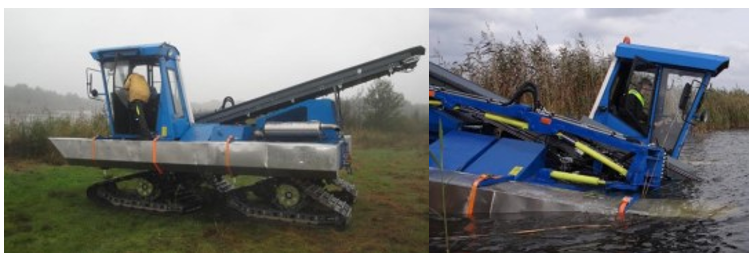Invention entitled ‘ System for attaching a buoyancy tank to an amphibious vehicle’ (Pat.234016/P.412908)
Description:
The object of the invention is a system for attaching a buoyancy tank to an amphibious vehicle. These vehicles are designed to carry out work in wetlands and inland bodies of water, especially in protected areas of national parks, landscape parks and Natura 2000 areas.
Work in difficult wetland areas involves mechanical mowing of grasses, reed beds, with the precaution of leaving the mown biomass in the field for one to two weeks for seed sowing, after which time the biomass is collected, loaded onto vehicles and transported to buffer stores. From the buffer stores, the dried biomass is successively transported to power plants that are adapted to burn renewable fuels, or the biomass is used to produce compost. In order to minimise the risk of the hovercraft becoming immobilised in the water, losing buoyancy and at the same time posing a danger to the pilot due to water entering the cabin after the vehicle has heeled, additional buoyancy tanks are mounted on the vehicle.
The essence of the system is that at least two support brackets in the form of metal plates symmetrically spaced along the length of the vehicle are connected to the earth and water amphibious vehicle separably, each plate being attached to the side or sloping wall of the vehicle by means of a bracket and a connector terminating on the side of the plate with a vertical bumper and a sloping bumper, or by means of two brackets and a lower and upper connector and ties attaching the buoyancy tank.
The hull of the tank is designed to accommodate additional equipment such as propeller motors used to improve manoeuvrability and the efficiency of cruising on bodies of water. Propulsion efficiency using propellers mounted under the buoyancy tanks is much better than propellers located under the vehicle hull, e.g. between track drive assemblies, due to the high water flow disturbance around the delta tracks.

Benefits:
- improved safety of the pilot driving the vehicle,
- possible improvement in the efficiency of maneuvering the vehicle in the field.
Status of legal protection:
The technology consists of patent Pat.234016 granted by the Patent Office of the Republic of Poland, in force from June 29, 2015.
Property rights to the invention are vested 100% in the Łukasiewicz Research Network – Poznań Institute of Technology.

Contact person:
Marek Szychta
Główny specjalista ds. konstrukcji maszyn rolniczych i leśnychSekcja Rozwoju Maszyn Rolniczych i Leśnych
Tel.: +48 514 796 358

